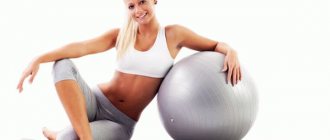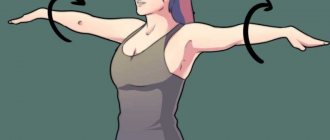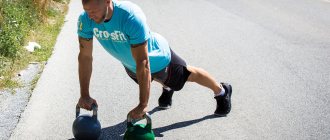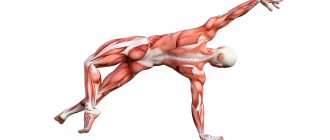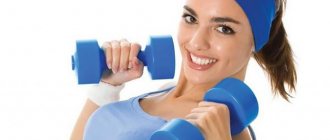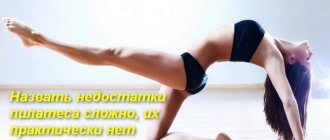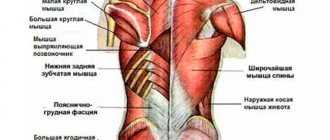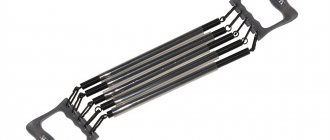Top 100 Best Exercises for Home Workout
Top 100 exercises for home workout Many people live only with work/study, and they have no time left for other interests. What to do if you want to both work and play sports? Just for such cases, below are the most productive exercises for home training that will work every muscle in your body and strengthen them (abdominal muscles, arms, buttocks, back, etc.). Home workouts are the best option, because not everyone has the time, and also the finances, to pay for a monthly subscription to a gym or fitness club. Some people simply don’t want to waste time getting to the gym and back. These not-so-complicated home exercises will help you get moving and gradually get in shape. Most people don't have sports equipment at home, but that's okay. You can perform exercises with body weight and achieve success.
- It is important to know that when doing exercises, nothing and no one should interfere with you.
- If you are doing the exercises and feel any discomfort, most likely you are doing the exercise incorrectly. Technique is very important in sports
- You need to focus not on how to do it faster, but on whether you are doing it right. There are a lot of videos on the Internet about how to do the exercises correctly; they will help you at first. By delving into the correct execution of exercises, you will greatly benefit from the work done.
- The technique also implies that you need to maintain proper breathing. The videos or descriptions underneath also tell you how to breathe better
- If you can't do certain exercises, don't get discouraged. It just takes time for your body to get used to it. Every time you perform an exercise that doesn’t work out, body parameters (for example, flexibility) will develop and the result will not be long in coming.
It happens that you can easily perform exercises with your body weight, you feel stronger and can do much more. Then you can apply weights. Not having a kettlebell or dumbbells at home is not a problem. Life hack: you can put water in a 5-liter bottle (or two 1-liter bottles). This will be a good alternative to dumbbells. Or you can put books in a bag/package, which will also serve as a replacement for weights. There are a lot of interesting and effective exercises for home. Choose more convenient exercises for yourself. You can experiment with increasing the weight (if you want), with rest intervals (rest more to restore strength, or rest less to build endurance), and the intensity of the exercises performed.
- Training should not be done every day. It takes 24 hours for your body to fully rest, so you can do it every other day.
Exercises for home training are suitable for everyone, so don’t be lazy, go towards your goal. Important! If you feel severe pain in your body, you should not engage in sports activities. Remember that your goal is to benefit, not harm, your body!
Basic rules when performing physical exercises
If you work out in a gym, then the instructor will always monitor the technique of doing the exercises, and, if there is such a need, he will definitely correct and clarify how to perform the physical exercises correctly.
If you bought a disc with a specific program (callanetics, Pilates or fitness), then you will have to control the correctness of the exercises yourself. Pay very close attention to the instructor's explanations, because in order to achieve the desired effect on certain muscle groups, you must perform them CORRECTLY.
Please watch this video in which Milena talks about the most common mistakes that beginners make in fitness.
To consolidate what Milena said, let's formulate the basic rules for performing physical exercises.
1. When performing the exercise lunge forward with a squat , the forward leg should bend at the knee at an angle of 90 degrees. Remember that to avoid injury, the knee should not come forward when bent , otherwise the kneecap will not thank you.
2. When performing an exercise on the back of the thigh, you need to pay attention not only to bending the leg, but also to FULL extension of it - and only after that can you return the leg to its original position. During extension, the thigh muscles work no less intensely, and sometimes with greater effect.
3. When performing exercises on the inner thigh, you also need to know the features of the various starting positions:
A) If you squat with your knees apart , then remember that your feet should be turned PARALLEL to your shoulders (as in ballet position No. 1) or at least strive for this as much as possible. In this case, the pelvis must be moved forward as much as possible . You will see how the French zone “works” immediately.
B) If you perform leg extensions from a supine position , then you need to raise your legs so that the angle between them and the body is 90 degrees. Otherwise, the abdominal muscles will work, which will distract you from the main zone, and you will still have time to work on the abs quite intensively.
C) If you lift your leg from the floor, lying on the same side , then keep in mind that the more you move your pelvis forward, the harder and more effective the exercise will be . If you “fall” on your butt, then two options are possible - either you simply wave your leg and do not achieve any effect, or you completely fall back and begin to work out... your front thigh. But it seems that we were not working for this area at all.
When working on the lateral thigh, the principles are very similar to the technique for performing exercises on the inner thigh. So, when swinging your leg up from a position lying on your side, you need to lean forward, as if “dropping” your stomach to the floor . In this case, the knee should point to the floor, and not to the ceiling or to the side. To make it easier to control the correct position, you can turn your heel towards the ceiling, lowering your toes towards the floor. And forward, or rather up!
If you are simply swinging your leg to the side, your heel should also extend towards the swing. And don't stay turned back.
If you are performing an exercise on the buttocks, lifting your straight leg up from the “knees and hands” position, then bow your foot and make sure that your leg does not go to the side . At the same time, it is advisable to pull your stomach in - this will reduce the load on your back.
Remember, you lift your leg with your gluteal muscle, not your lower back. It is better not to try to raise your leg too high if this is achieved only by arching your back.
When lifting your leg up from a prone position, you need to remember the “four bones” rule - the clavicle bones must remain firmly pressed to the floor . Sometimes even a slight pain is felt in this area from the pressure of the bones on the floor.
Only the leg should rise, and not the entire left side of the abdomen along with it.
6. When performing an
upper abdominal exercise from a lying position on the floor , when you simply lift your upper torso, your shoulder blades should rise, not your entire body . And under no circumstances “pull” your head with your hands if you have clasped the back of your head with your hands.
It is better to place your hands not clasped behind your head, but unhook them and slightly move them apart from each other to the sides. This way, you will no longer be able to harm the cervical vertebrae, since you will not make a sharp jerk in an effort to help raise the torso. And one more general rule . Don't try to do everything exactly the way the girls do it on the screen.
Did you know that often when filming such a program, the instructor does only one exercise per day so that the effect of fatigue from performing the previous ones is not visible.
Under such conditions, you would look cheerful. So if you can't lift your leg that high, it doesn't mean the exercise won't be effective. The main thing is to do it to your limit.
Some Important Exercise Rules

Description
To achieve maximum results from exercise, you must follow a few simple rules.
Failure or even harm may result if they are ignored. In order to achieve certain results in gymnastics, the principle of progression
- from simple to complex, from easy to difficult - to the extent that muscle strength and coordination increase. Progressivity must be carried out as quickly as possible, because the goal is to achieve as much as possible in the shortest possible time. But when performing different movements in the experiment, a certain order was demonstrated to eliminate even the semblance of tension or damage to health. For exercise to have real and lasting benefits, it must be done regularly, more or less systematically. Disorderly methods bring little results. Trying to fit all the exercises into a few daily hours during your annual leave and then ignoring those exercises for the rest of the year is a waste of time. This will not develop muscles or strengthen the nervous system. The benefit from this is small and temporary.
At the beginning, the exercises should be easy, in certain cases even with assistance. The intensity of the exercises gradually increases as the person performing them gains strength. This is especially necessary in the case of the weak and sick. Overweight and slow, lazy, as well as thin and nervous people should not rush into vigorous exercise without proper preparation.
Muscles need to be contracted to maximum tension
. Then relax them completely. The joint must go through its full range of motion, with the limits of motion determined by the constitution of the body. Each movement must be preceded by a movement in the opposite direction. Care must be taken not to bring the body through exercise to a state of fatigue, nervous exhaustion and impaired blood circulation. If the exercise is followed by body trembling, dizziness, heavy breathing, blue lips, prolonged fatigue, and other extreme conditions, then this means that overexertion has occurred, and the exercises have gone far beyond the limits of usefulness.
Except in cases where greater endurance
, exercises should not be continued after a slight feeling of fatigue. The required load of the exercise depends mainly on the endurance and strength of the subject. A general safety rule is to stop the exercise as soon as the muscles become too tired to continue vigorously; further exercise should be preceded by a few minutes of rest.
Exercise should not be done for at least an hour after eating
. Dr. Oswald writes: "Animals rest after eating, and some of them do not fall asleep until they have received a sufficiently large quantity of food." Food absorption occurs best during rest and sleep. And physical activity interferes with such absorption. Due to the pleasantly stimulating nature of light exercise, it is best done in the morning, before breakfast. Doing them in the evening invigorates. On the other hand, on the contrary, it is better to perform heavy exercises in the evening, because they encourage sleep. Doing heavy exercise in the morning is also not beneficial because it makes you tired before the day's work.
Muscle building
intensified by alternating work and rest. If you are to make progress in your development, then it is necessary that periods of rest are commensurate with the volume and intensity of periods of physical activity. Some of our “intellectuals” admit that a certain amount of physical exercise is necessary, but then scientifically declare the dangers of “overdevelopment.” But in fact, “superdevelopment” is impossible. If an exercise is performed beyond its usefulness, that is, when it is performed excessively, the destruction of tissue and the expenditure of energy in this case is greater than they can be replenished, and then exhaustion and atrophy occur. And if the exercise is not performed to the point of excessiveness, it certainly cannot lead to overdevelopment and is not capable of causing harm.
If a practitioner gives, as, for example, when caring for a patient, a resistance movement, then it should be slow, and the resistance should be smooth and even. The resistance value should gradually increase
to the middle part of the movement and then gradually decrease.
In most cases, at least, resistance is provided by power and other relevant equipment and projectiles. When recommending resistance movements, Dr. Baron Passe notes: “The resistance should be at right angles to the lever (so that the weight lever does not change during the exercise), for this gives a more stable movement and is more comfortable for the patient. The only change in the resistance process should be a change in pressure
(weight), which should be increased as the lever of force increases (towards the middle part of the exercise). Resistance throughout the entire time must be moderated so as to give the movement the same speed - slow rather than fast - and movement in jerks or with resistance causing trembling, vibration must be eliminated, for, being manifestations of overexertion, neither one nor the other corresponds to normal muscle contractions and causes undesirable effects on muscle fibers and motor nerves. Adjust the resistance carefully and according to the patient's strength; Remember that therapeutic exercises are not combat exercises such as wrestling, and even a small resistance is enough to increase muscle activity with an accompanying result that exceeds the activity of daily life or the activity of individual movements. Resistance is often brought to the highest possible ability of the patient (with his nervous capacity within the limits of normal fatigue), then it is a matter of obtaining the greatest pressure to displace bone, cartilage, etc.
The resistance should be applied sufficiently to cause fatigue in the organ within 8-10 movements. There should be a short period of relaxation between each movement. In each case, movement must be considered in relation to the needs and strength of the patient. Every week the patient should be given a day off from exercise. If the patient is very weak, he should be given a two-day rest every week. Adequate rest between exercise sessions is as important as the exercises themselves. Recovery from complete fatigue takes twice as long as at the onset of fatigue. Workers who are rested to the point of exhaustion do more work and better work. This is the reason that early sleep - “beautiful sleep” comes before you are completely tired. Women who go to bed late are more tired than those who go to bed early.
In a sick person, the recovery ability is more or less impaired or limited. Therefore, for him, exercise that is too vigorous or too long is harmful. They will definitely tire him out, since due to impaired recovery ability and injured body processes, he does not recover so quickly. If we are not careful, our efforts to help the patient may actually make his condition worse.
One of the first goals of scientific gymnastics
consists of teaching the patient to avoid all useless and wasteful physical efforts and movements, to perform any work with the least waste of energy.
Delsartinism
* emphasizes the need to conserve energy. This system teaches its followers and students to relax and rest all parts of the body that are not actually occupied with the work performed by the body every moment. A follower of the Carrick Le Farve system writes: “We must learn to spend so little energy that there is enough of it in reserve to respond to all the calls that can come from the inner (state) of a person.
* Francois Delsarte (1811-1871) - French teacher in the field of dramatic and musical expression. Delsartinism is a system of rhythmic gymnastics and floor exercises based on the theory of Francois Delsarte.
We weaken ourselves by wasting our strength. We don't need to produce more energy. But we must practice control and wise management of the forces we already have. Every day I see weak people wasting energy doing work meant for three strong people. The ability to conserve energy would be an immediate salvation for these people. How to achieve this? Relax all parts of your body that are not directly related to what you are doing.”
Saving vital forces is in itself a source of energy reserves. And if you practically learn to give rest to organs that are not directly related to the action being performed, you will learn a valuable lesson.
It is unwise to either start or stop any work too suddenly and on too large a scale. In a calm state - sitting or lying down, etc. - the bulk of the blood is in body cavities such as the head, chest, peritoneum and pelvis; both venous and lymphatic circulation are sluggish. To do your job best
, the blood in the muscles must be proportionate in volume to the work required of them. Vigorous muscular work requires that the bulk of the blood flow through the muscles at high speed and with high pressure. The relative accumulation of blood and the increase in its speed and pressure begin already at the beginning of active muscle work, narrowing of the arteries in the main cavities of the body, especially in the abdominal cavity, and dilation of the arteries in the muscles and the vascular system of the skin occur. Such a major circulatory adaptation cannot be carried out satisfactorily or reliably enough to produce the work required of the muscles if the muscles are suddenly forced to work quickly and vigorously. It takes some time for the circulatory mechanism to adapt to the changing demands of the body. Sudden great demands placed on the heart and arteries are stressful for them. Sudden intense exertion, when the heart is still beating slowly and blood pressure is low, can easily cause undesirable subjective symptoms such as painful throbbing in the side and front of the neck, so common after strong exercise that has not been preceded by a period of preparation.
From the point of view of the development of the body, the most beneficial is always a gradual increase in the quality and intensity of muscle exercises. Then not only does circulatory adaptation occur in the best way, but the respiratory and excretory systems also adapt in the best way. Trainers of both humans and horses almost always recognize the inadvisability of starting work too quickly and too hard, and put their charges through a warm-up period before giving them the real work. This kind of preparation starts up the machinery of life and makes it run smoothly before it is subjected to real stress. This saves energy. Anger, fear, and other arousal emotions can serve the same purposes as “warming up.” This means that "warming up" can accelerate the functional activity of the liver, adrenal and other glands in the same way that the emotions of fear and anger do.
“Warming” can be considered as a means of mobilizing the body’s forces.
The moment of coordination also deserves attention.
.
Everyone knows well that we cannot perform delicate, delicate work after severe stress. But it is probably not so universally recognized that it is much more difficult to control the general amount of movement and to make the right efforts and proper coordination in any difficult task without a preliminary “warmer” than with it. Gradual "warming up" and a reasonable distribution of work prove to save energy and reduce the possibility of stress and tension. Then there is better work, better coordination and better effort on the part of the muscles and all organs. If any organized and systematic work is started too suddenly, then most likely there will be a need to slow down its pace later. And such a decrease in the rate of muscle effort means a greater or lesser loss of the accumulated efforts of the whole organism and often causes an undesirable effect. It's best to start with a light effort and gradually build up to your highest level
. It is also undesirable and even always unsafe to suddenly stop vigorous efforts during high activity of the body, when the heart and lungs are still working strongly, the glands are functioning at high speed, and the skin is hot and covered with sweat. The horse rider is wise to take the horse by the bridle after a ride and walk him, giving him the opportunity to gradually reduce his activity until the blood circulation and sweating system return to normal. The sudden cessation of vigorous work imposes the same stress on circulatory adaptation as the sudden onset of strenuous work. It is best to gradually reduce the amount and intensity of muscle work. To reduce the body's activity, you can also use passive deep breathing.
Before prescribing exercise for a patient, the practitioner must assess his general condition and the condition of certain organs. Without proper care, exercise can cause serious damage in some conditions. Before prescribing exercise, evaluate:
- The condition of the patient's heart and lungs.
- Blood pressure and condition of the arteries.
- Degree of development and muscle tone.
- Strength and endurance.
- Joint mobility.
- Displacement (if any) of organs and joints.
- Current disorders, disorders.
- Type of individual: nervous or phlegmatic (note: slow movements with frequent relaxation should be used for the first type of people, accelerating exercises for phlegmatic people).
In some conditions, exercise must be completely avoided until a significant improvement in the patient's condition is achieved. In other cases, the exercises can be used, but every precaution is necessary to avoid harm. The following are two types of such conditions:
Contraindications
:
- Acute form of the disease.
- Cardiac decompensation.
- Very high blood pressure.
- Articular tuberculosis (unaffected joints are subject to training).
- Acute inflammation of joints or muscles (unaffected joints or muscles can be trained).
Conditions requiring caution
:
- Excessive exhaustion.
- During prolonged fasting.
- Diseases of the spine (especially tuberculosis).
- Aneurysm or vascular damage.
- High blood pressure.
- Heart and circulatory disease.
- Low energy (exhaustion of the nervous system).
- Neurasthenia.
- Tuberculosis.
- Pregnancy (usually too afraid of exercise).
- Abscesses.
- Hemorrhoidal conditions.
- Prostatitis, inflammation of the uterus, intrauterine inflammation, oophoritis (inflammation of the ovaries), inflammation of the pelvic subcutaneous tissue or loose connective tissue, uterine hemorrhage, chronic menstrual disorder (dysmenorrhea), inflammation of the bladder (cystitis).
Unfortunately, our leaders in health and wellness have not freed themselves from the shackles of witch doctor thinking
, and this type of thinking carries over into the field of physical education. We find many things advocated by physical education instructors that have no value or are downright harmful. Alcohol rubs, rubbing skin lotion into the ligaments before and after exercise, massage - all these are not only in vain, but also harmful. Such healing techniques do not close the pores or eliminate the toxins produced during exercise. Such instructors are usually full of prejudices regarding nutrition of the joints, various rubbings on the skin, bathing the ligaments in a solution of saltpeter and cold water, and similar things. One famous bodybuilder, after being advised to use ointment to massage his joints, said: “Saturating the tissues with fat serves not only as a lubricant, but also as nutrition for worn-out tissues.” This is pure nonsense! It is recommended to apply compresses with hot olive oil over and around the joint of the damaged organ and leave it overnight. It is said that during sleep it provides nutrition to tissues and lubrication to joints, thereby making them mobile and more pliable to exercise. But the oil is not only not absorbed into the tissue, but also turns out to be useless. You need to know that before tissues can use any oil, it must be absorbed, and this cannot happen in the skin.
Most physical education instructors imagine that massage has some value in the physical education program, and every gymnasium has one or two massage therapists. Some have their own massage therapists; Most athletes use massage. That massage partially eliminates muscle soreness and joint stiffness cannot be denied. But like all palliatives, half-measures, if continued, it becomes a source of harm.
Massage is a very innervating process. Its true nature is revealed in the fact that, for example, a boxer must stop using it a few days before his fight, otherwise he will enter the ring in bad condition.
—-
Article from the book: Natural hygiene - the science of life | Herbert SHELTON
